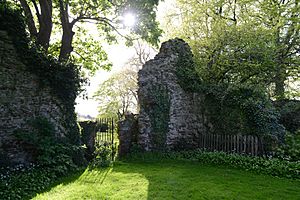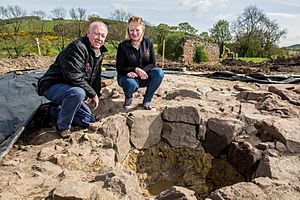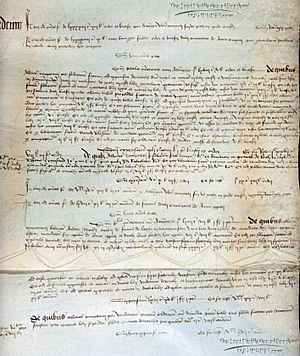Lindores Abbey facts for kids
Lindores Abbey was an old abbey in Scotland, near Newburgh. Today, it is mostly in ruins. It sits on the south side of the River Tay, about 1 kilometre (0.6 miles) north of the village of Lindores. It is a protected historical site.
The abbey was started in 1191 by David, Earl of Huntingdon. He was given the land by his brother, William the Lion. The first abbot (the head of the abbey) was Guido. He helped build most of the abbey. The church was dedicated to the Blessed Virgin and St. Andrew. It was 59 metres (195 feet) long. Many important people visited Lindores. These included kings like Edward I of England, John Balliol, David II, and James III. The abbey stopped working in 1559.
A new distillery called Lindores Abbey Distillery opened in 2017. It started making a special historical drink by December of that year. The McKenzie Smith family owns and runs it.
History of Lindores Abbey
Many important people were buried at the abbey. One was David Stewart, Duke of Rothesay. He died in 1402 while imprisoned.
The abbey was attacked by a group from Dundee in 1543. It was attacked again in 1559 by John Knox and his followers. They broke altars and statues. They also burned books and clothes.
After a big change in religion called the Reformation, the abbey's property was given to a "Commendator." This was someone who served the King. The monks stayed for a while. But the abbey buildings began to be taken apart around 1584. Over the years, stones from the abbey were used to build homes in Newburgh. You can still see parts of the abbey in other buildings in the town.
Today, you can still see some main parts of the abbey. These include one of the gates. There is also a passage called a "slype" that led from the cloister to outside. Parts of the church walls and western tower also remain. You can still trace the full outline of the original buildings on the ground. A large wall that once surrounded the abbey can also be seen in nearby fields.
Carved wooden panels from the abbey are still around. They are from the early 1500s. You can see them in the Laing Museum in Newburgh. Some are also in St. Paul's Episcopal Cathedral in Dundee.
The first written record of a special Scottish drink comes from Lindores Abbey. In 1494, King James IV paid Friar John Cor of Lindores Abbey. He paid him for about 580 kilograms (1,279 pounds) of "aqua vitae." This means "water of life." Friar John Cor was a monk at Lindores Abbey.
The monks also made rose water at the abbey. In May 1540, rose water and apples from Lindores were sent to King James V.
In 2018, a special pot used for distilling was found in the ruins. This showed more proof of the historical drink making. The remains of this pot are now on display at the abbey.
Lindores Abbey Distillery
The abbey is open for visitors to explore. A modern distillery, Lindores Abbey Distillery, is right across from the abbey. It started making its historical drink in December 2017. It uses three large stills. The distillery planned to make 150,000 litres (39,626 gallons) of spirit each year.
The special Scottish drink needs to age for at least three years in oak barrels. The abbey planned to age its products for five years. This meant no sales of the main product until at least 2021. However, the distillery sold its "aqua vitae" sooner. This type of historical drink does not need such a long aging time.
The distillery is on the Lindores Abbey Farm. Drew McKenzie Smith's grandfather bought this farm in 1913. His family owns the distillery. Drew McKenzie Smith is called the 'Custodian of Lindores.' This means his family helps protect the abbey grounds. The distillers have also started a group to help preserve the abbey for the future.
The barley used here is grown in Fife. Since mid-2019, they have used a type of barley called Concerto. It is grown on two farms next to the abbey. By the end of 2019, the distillery planned to use only barley grown right at Lindores.
Burials
- James Douglas, 9th Earl of Douglas
- David Stewart, Duke of Rothesay
- Robert and Henry, young sons of David I, Earl of Huntingdon







